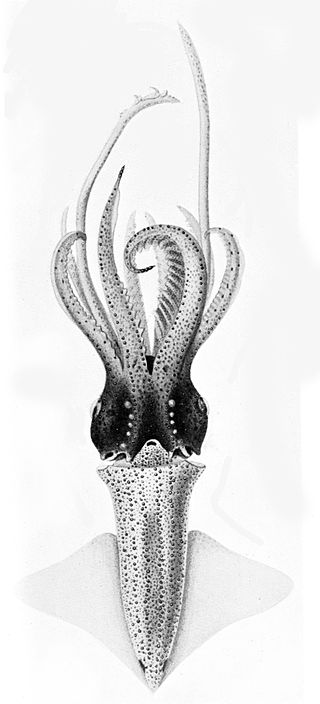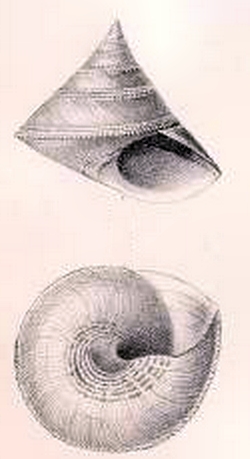
The hammerhead sharks are a group of sharks that form the family Sphyrnidae, named for the unusual and distinctive form of their heads, which are flattened and laterally extended into a cephalofoil. The shark's eyes are placed one on either end of this T-shaped structure, with their small mouths directly centered and underneath. Most hammerhead species are placed in the genus Sphyrna, while the winghead shark is placed in its own genus, Eusphyra. Many different— but not necessarily mutually exclusive—functions have been postulated for the cephalofoil, including sensory reception, manoeuvering, and prey manipulation. The cephalofoil gives the shark superior binocular vision and depth perception.

Inia is a genus of river dolphins from South America, containing one to four species.

The harbour porpoise is one of eight extant species of porpoise. It is one of the smallest species of cetacean. As its name implies, it stays close to coastal areas or river estuaries, and as such, is the most familiar porpoise to whale watchers. This porpoise often ventures up rivers, and has been seen hundreds of kilometres from the sea. The harbour porpoise may be polytypic, with geographically distinct populations representing distinct races: P. p. phocoena in the North Atlantic and West Africa, P. p. relicta in the Black Sea and Sea of Azov, an unnamed population in the northwestern Pacific and P. p. vomerina in the northeastern Pacific.

Enoploteuthidae is a family of squid comprising approximately 40 species in four genera. Most species have a mantle length ranging from 3–13 cm (1.2–5.1 in). Hooks are present on all arms and tentacles. The family is best known for the large array of photophores throughout the body.
The conservation status of a group of organisms indicates whether the group still exists and how likely the group is to become extinct in the near future. Many factors are taken into account when assessing conservation status: not simply the number of individuals remaining, but the overall increase or decrease in the population over time, breeding success rates, and known threats. Various systems of conservation status are in use at international, multi-country, national and local levels, as well as for consumer use such as sustainable seafood advisory lists and certification. The two international systems are by the International Union for Conservation of Nature (IUCN) and The Convention on International Trade in Endangered Species of Wild Fauna and Flora (CITES).

Abraliopsis is a genus of squid in the family Enoploteuthidae, comprising 11 nominal species. Species are characterised by the presence of photophores on arm pair IV. Suckers are absent from this arm. The type species is Abraliopsis hoylei.

Abraliopsis morisii is a species of bioluminescent squid in the family Enoploteuthidae. The species occurs in tropical to warm temperate waters in the Atlantic Ocean, including the Gulf of Mexico and the Mediterranean Sea. It can be found in the epipelagic and mesopelagic zones. Jean Baptiste Vérany described the species in 1839 and it reaches lengths of 25 to 33 millimetres. It is rated as least concern by the International Union for Conservation of Nature (IUCN).
Comitas chuni is a species of sea snail, a marine gastropod mollusk in the family Pseudomelatomidae, the turrids and allies.

Calliostoma chuni is a species of sea snail, a marine gastropod mollusk in the family Calliostomatidae.
Monorhaphis is a monotypic genus of siliceous deep sea Hexactinellid sponges. The single species is the type species Monorhaphis chuni, a sponge known for creating a single giant basal spicule (G.B.S.) to anchor the sponge in the sediments. The species was described by Franz Eilhard Schulze in 1904 from specimens collected by the German Deep Sea Expedition in 1898–1899. Monorhaphis is also the only genus in the monotypic family Monorhaphididae.
Abraliopsis affinis is a species of enoploteuthid cephalopod in the tropical waters of the eastern Pacific Ocean, and is known from Chile, Colombia, Costa Rica, Ecuador, El Salvador, Guatemala, Honduras, Mexico, Nicaragua, Panama and Peru. It was described by Pfeffer in 1912 and is rated as a least-concern species by the IUCN.
Abraliopsis atlantica is a species of enoploteuthid cephalopod found in the tropical and subtropical Atlantic Ocean, including the Caribbean Sea, the Gulf of Mexico and the Benguela Current. Female oocytes are around 1 mm in length and number between 4,000 and 29,000 in mature females. There is a lack of information about the species and it is rated as data deficient by the International Union for Conservation of Nature (IUCN) due to this. It was described by Kir Nesis in 1982.
Abraliopsis falco is a species of enoploteuthid cephalopod found in the tropical waters of the East Pacific Ocean, and is known from Chile, Colombia, Costa Rica, Ecuador, El Salvador, Guatemala, México, Nicaragua, Panamá, Perú and the United States. Females are larger than males, reaching sizes of 41–46 mm mantle length, with males reaching 35–37 mm mantle length.
Abraliopsis gilchristi is a species of enoploteuthid cephalopods found in southern temperate waters of the south Pacific Ocean, from New Zealand to South Africa, where it is abundant. It undergoes a vertical daily migration, spending the day at depth and moving closer to the surface at night to feed on copepods, euphausiids and hyperiids. Spawning appears to occur between September and December. The specific name honours the Scottish zoologist John Gilchrist (1866-1926) who was the first director of the Marine Biological Survey in Cape Town. The type specimen was taken off Cape Town and is held in the Natural History Museum, London.

Abraliopsis hoylei is a species of enoploteuthid cephalopod whose type locality is the Mascarene Islands, but this is uncertain, and the type specimen has been damaged, making taxonomic determination difficult.
Abraliopsis lineata is a species of enoploteuthid cephalopod native to Indo-Pacific waters, from the Arabian Sea and the Mascarene Islands in the west to Japan, Indonesia and French Polynesia in the east. It occurs in relatively shallow water at depths of ~100 m during the day.
Abraliopsis pacificus is a species of enoploteuthid cephalopod from the northwestern Pacific Ocean, from Japan to Hawaii. This species undergoes vertical migration from 900–500 m depth during the day, rising to 263–102 m depth at night. Male spermatophores are 6.5–7 mm in length.
Abraliopsis tui is a species of enoploteuthid cephalopod found in the waters around New Zealand and the Kermadec Islands.
Chlidonophora chuni(Blochmann, 1903) is a extant species of brachiopods in the family Chlidonophoridae.

Abraliopsis pfefferi, also known as Pfeffer's enope squid, is a species of squid from the genus Abraliopsis. The species has been observed in the North Atlantic Ocean.









